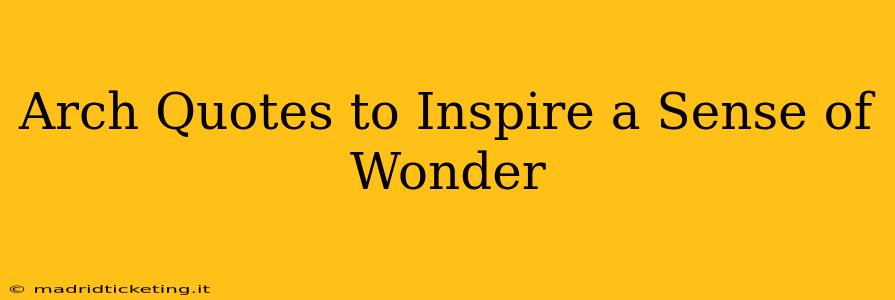Architecture, at its best, transcends mere shelter; it becomes a powerful conduit for inspiring awe and wonder. From the soaring heights of gothic cathedrals to the minimalist elegance of modern structures, the built environment has the remarkable ability to evoke profound emotional responses. This article explores captivating quotes about arches, highlighting their aesthetic power and symbolic resonance, and delving into the wonder they inspire. We'll also explore some frequently asked questions surrounding arches and their impact.
What Makes Arches So Inspiring?
Arches, fundamental elements in architecture spanning millennia, hold a unique position. Their graceful curves, inherent strength, and ability to span vast distances without intermediate supports create a sense of both power and delicate beauty. This inherent duality contributes significantly to the sense of wonder they evoke. They represent a triumph of engineering and artistry, a testament to human ingenuity and creativity. The subtle play of light and shadow across their curved surfaces further enhances their visual appeal, adding depth and mystery.
The Symbolic Significance of Arches
Beyond their aesthetic appeal, arches carry rich symbolic weight. They have long been associated with:
- Transition and Passage: Arches often mark entrances and thresholds, symbolizing a passage from one space to another, a journey into the unknown, or a transition between different realms of experience.
- Strength and Stability: Their inherent structural integrity represents enduring strength and stability, capable of withstanding the test of time. This resilience resonates deeply, offering a sense of security and permanence.
- Heaven and Earth: The upward curve often evokes a sense of reaching towards the heavens, connecting the earthly realm with the divine. This celestial connection adds to their spiritual and symbolic significance.
- Triumphal Entries: Triumphal arches, in particular, celebrate victory, power, and achievement. Their majestic scale and ornate detailing amplify this sense of grandeur.
Famous Arch Quotes that Capture Wonder
Many renowned architects and thinkers have eloquently expressed the inspiring power of arches. While attributing precise quotes to specific individuals regarding only arches proves challenging, we can highlight quotes that speak to the essence of architectural wonder, easily applicable to the awe inspired by arches:
- "Architecture is the learned game, correct and magnificent, of forms assembled in the light." - Le Corbusier: This speaks to the interplay of light and form crucial to the visual impact of arches.
- "Form follows function - that has been misunderstood. Form and function should be one, joined in a spiritual union." - Frank Lloyd Wright: While not specifically about arches, it speaks to the harmonious blend of aesthetics and practicality found in well-designed archways.
- "Architecture should speak of its time and place, but yearn for timelessness." - Henry Plummer: This encapsulates the enduring appeal of arches, transcending fleeting trends to remain relevant across generations.
What are Different Types of Arches?
Arches come in various forms, each with its unique aesthetic and structural properties:
- Round Arches (Roman Arches): These classic semicircular arches are known for their simplicity and strength.
- Pointed Arches (Gothic Arches): These pointed arches, characteristic of Gothic architecture, allow for greater height and span.
- Horseshoe Arches: These arches, common in Islamic architecture, are characterized by their distinctive curved shape that extends beyond a semicircle.
- Tudor Arches: These four-centered arches feature a flatter curve compared to round arches.
- Segmented Arches: These arches consist of multiple segments, creating a more complex and dynamic curve.
How are Arches Constructed?
The construction of arches involves a precise process that requires careful planning and execution. Key elements include:
- Voussoirs: These wedge-shaped stones are carefully placed to create the arch's curve.
- Keystone: The central stone at the apex of the arch, crucial for its stability.
- Impost: The supporting structure upon which the arch rests.
The construction methods vary depending on the type of arch and the available materials.
Why are Arches Used in Architecture?
The use of arches in architecture stems from their inherent strength and aesthetic qualities. They allow for the creation of wide openings without the need for intermediate supports, leading to larger and more open spaces. Arches also offer a unique visual appeal, adding elegance and grandeur to buildings.
What are some examples of famous arches?
Many famous structures feature iconic arches. Examples include:
- The Arc de Triomphe, Paris: A triumphal arch commemorating French military victories.
- The Gateway Arch, St. Louis: A modern marvel of engineering and architecture.
- The Arches of Petra, Jordan: Ancient rock-cut arches that exemplify human ingenuity and craftsmanship.
These examples, and countless others, showcase the enduring appeal and architectural significance of arches.
Conclusion: The Enduring Wonder of Arches
Arches, with their inherent beauty, structural ingenuity, and symbolic resonance, continue to inspire a sense of wonder. From ancient ruins to modern masterpieces, they stand as testaments to human creativity and the power of architecture to evoke profound emotional responses. Their enduring appeal underscores their timeless significance in the world of design and architecture.

